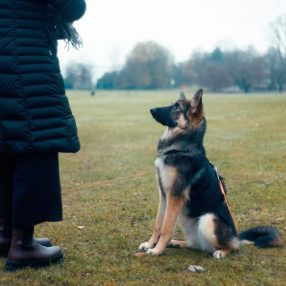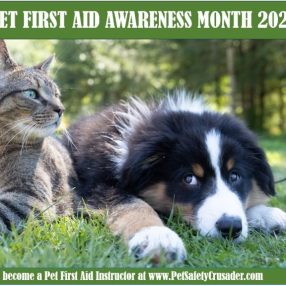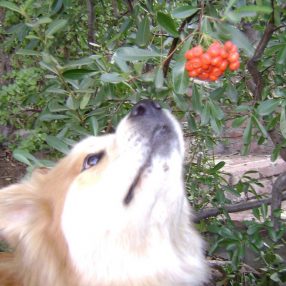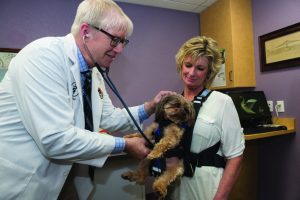 Dr. Marty Becker, “America’s Veterinarian,” has spent his life working toward better health for pets and the people who love them. He was the resident veterinary contributor on “Good Morning America” for 17 years, is currently a member of the Board of Directors of the American Humane Association as well as its Chief Veterinary Correspondent, and is a member of the Dr. Oz Medical Advisory Panel.
Dr. Marty Becker, “America’s Veterinarian,” has spent his life working toward better health for pets and the people who love them. He was the resident veterinary contributor on “Good Morning America” for 17 years, is currently a member of the Board of Directors of the American Humane Association as well as its Chief Veterinary Correspondent, and is a member of the Dr. Oz Medical Advisory Panel.
Marty Becker has written 25 books that have sold almost 8 million copies, including three New York Times best-sellers — one of which is the fastest-selling pet book of all time, Chicken Soup for the Pet-Lovers Soul. He has been a contributor to Parade magazine, Reader’s Digest and AARP.com and writes the weekly nationally syndicated newspaper feature Pet Connection with his writing partner, Kim Campbell Thornton. “Animal Radio” hosts Dr. Becker monthly as their Chief Veterinary Correspondent, and he is also featured in Dogster, Catster, and Vetstreet.
Wait, there’s more! Dr. Becker is an adjunct professor at his alma mater, the Washington State University College of Veterinary Medicine, and also at the Colleges of Veterinary Medicine at both Colorado State University and the University of Missouri. Additionally, he has lectured at EVERY veterinary school in the United States, and is on the advisory board of World Vets, an international veterinary and disaster relief program to help animals. Dr. Becker also serves as the Chief Veterinary Correspondent for the American Humane Association, focusing on their efforts to end the use of gas chambers in animal shelters. His special fondness for older pets has led him to sit on the Advisory Board of The Grey Muzzle Organization, whose mission is to make sure no old dog ever dies alone or afraid. He still practices at North Idaho Animal Hospital because Dr. Becker hasn’t forgotten the core reason he excelled – he loves veterinary medicine, pets and the people who care for them. There’s much more to his resume, but with this kind of schedule, I find it amazing he made time to talk with me about his Fear FreeSM initiative which “takes the ‘pet’ out of ‘petrified’” and gets animals the medical care they need by promoting a gentle hand and a calm environment.
Dr. Becker explained to me how the idea for Fear FreeSM was born, “I gave a keynote in 2009 on Vancouver Island in Victoria. The next day, a board certified behaviorist, Dr. Karen Overall, spoke. I was in the back of the room listening as she started, ‘Fear is the worst thing a social species can experience. It causes permanent damage to the brain!’ She went on to explain signs of fear and panic in animals, and I realized that although I had the best of intentions, wanting to help, never hurt my animal patients, I had actually been causing some physiological damage. I was absolutely nauseous!” Dr. Becker shared the process of an animal coming into a veterinary practice and everywhere he turns, he smells a vertical or horizontal surface where 1,000 other dogs have left signals of fear behind. The dog goes to the scale and/or gets lifted up on to a cold, slippery table where again, the fear pheromones exude. The veterinarian, towering above, makes direct eye contact with the full width of his body over the pet and places a cold stethoscope against his chest, the bell of which reeks with that smell of fear! Now, we’re not implying clinics are dirty. They are certainly cleaned with ample cleansers and bleach, but a good whiff of bleach and our furry best friend, so dependent on his sense of smell, is now nose-blind for 7 days! The scared pet next gets 2 or 3 ‘bee stings’ in the form of vaccinations and then gets the heck out of there, hoping never to return.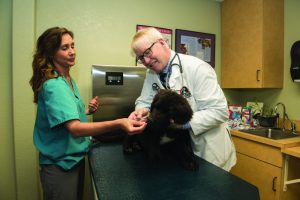
Dr. Becker refers to all of these unintentional calamities as collateral damage of getting our dogs and cats examined by veterinary professionals. He credits Dr. Overall for getting him to his transformative moment when she drew a parallel to the human health care system of the 50s-60s reminding him of being told, as a child, not to embarrass the doctor by crying when he was given a shot. “Children are dependent beings. They don’t go to the doctor by free-will and depending on age, you can’t explain to them that, ‘You’re going to get an injection that may sting, but it’s going to fight bacteria in your body and relief of your aches and pains may be only moments away,’ he articulates.
I listened as Dr. Becker, like I hope all veterinarians would, stated that nobody gets into veterinary medicine to make life worse for animals. He shared fondly the fact that his granddaughter LOVES to go to the dentist where she’s placed in a room with several other patients and gets to pick the colors of the LED lights shining down, chooses a video, is given noise-cancellation headphones, a blanket, even animal-assisted therapy if needed, while her mom massages her neck (I want to go to her dentist!). Upon leaving the clinic, she’s rewarded, not with a toothbrush, but with a selection of toys. Pediatric medicine, dentistry and oncology are looking after the physical and emotional well-being of the patient, so the lightbulb lit and Dr. Becker proclaimed, “We must do the same for the animals!”
Leaving the conference, he went straight to the Board of Veterinary Behavior determined to fix the problems by gathering together an advisory group which has now grown to 225 people. “I graduated from veterinary school in 1980 and had been taught that pets didn’t feel pain like we do. Baloney!” shouts Dr. Becker. “They have the same neuropathways and feel the emotions of fear, anxiety and stress and all that lives in their amygdala (almond-shaped part of the brain that stores emotions). If nails are trimmed too short, the pet feels pain and continues to be disturbed by the sight of the clippers. Same with an injection and the syringe. We now understand the benefits of giving pain and anxiety meds BEFORE the first person lays hands on a pet.”
I next asked him to describe the fearful behavior he had observed in animals over the years when coming for a vet check-up. “This is really interesting – another epiphany,” he shared. “Let’s take a dog — licking lips, yawning, salivating, shivering, making circles, leaning away from stress, hiding, panting, heart racing, shaking as if they were wet. Some even lay with eyes closed which is a behavior farthest down the Defense Cascade, meaning here’s where they have given up the battle.” NOTE: In the Defense Cascade, first comes ‘Alert’ (muscles tense, heart rate increases) followed by ‘Fight or Flight’ (active defense to deal with the stress), and lastly ‘Collapsing Immobility” (pet shuts down in response to an inescapable threat). The dog or cat is experiencing the greatest degree of trauma.
Wow! At this point I’m assessing that Fear FreeSM must be a bit like having a good “bedside manner” but on steroids! Dr. Becker concurred, “Veterinarians need to see themselves as pet pediatricians for life. We can’t explain that what we’re doing is to relieve pain, so we have to show this through gentleness and species-appropriate actions.”
Other than the primary reason of kindness, this is so important because many pets are not getting the care they need as owners feel it is more stressful to bring them to the vet for help. When dogs and cats are afraid, their leukocytes shift (white blood cells of the immune systems), meaning blood panels and other testing doesn’t provide true readings of their health due to their elevated fear and anxiety. According to Dr. Becker, “The veterinary profession is the only one where the injury rate (cat scratch or a dog bite) is 100% for every person every year. We’ve obviously been coming at animals’ fear all wrong.”
His guidelines for veterinarians and anyone working around pets: 1) Use your ‘sanctuary voice’ not your ‘game day voice.’ 2) Have the room loaded — everything in the room ahead of time so you don’t keep going in and out. 3) Reduce your profile by turning sideways to the pet and give soft glances, not direct eye contact. 4) Give the animal the choice as to where the exam will take place, don’t automatically put them up on that table. 5)Use control or positioned compliance as oppose to restraint, offer high value treats to lure them to you. 6) Tent the skin. Release. Tent the skin. Release. Tent the skin, and then give the injection. Don’t just grab and bee sting them! Says Dr. Becker, “Your voice, body language, physical touch, cleaning of instrumentation all contribute to the pet’s success.” He suggests cleaning tools with a peroxide-based cleaner and then wiping with species-appropriate pheromones, getting rid of the fear pheromones left behind by the previous patient. He says, “Fear FreeSM is a way of thinking about catering to the pet. Not getting him in & out and trying to prevent being injured yourself.”
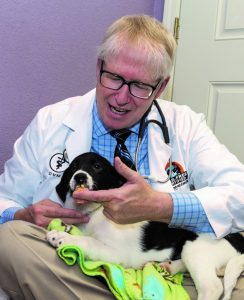 So what is done differently for cats vs. dogs? Curating the room for starters. Cats get warmed towels sprayed with Feliway®, iCalmCats® music is played (recorded at a cat’s resting heart rate) and feline pheromones are wiped on the table and all instrumentation (ie: stethoscopes, otoscopes, the scale).
So what is done differently for cats vs. dogs? Curating the room for starters. Cats get warmed towels sprayed with Feliway®, iCalmCats® music is played (recorded at a cat’s resting heart rate) and feline pheromones are wiped on the table and all instrumentation (ie: stethoscopes, otoscopes, the scale).
What do dogs usually do before they enter vet office? Answer nature’s call right outside. Cats don’t get this opportunity, so they are stressed out along with having a full bladder! Dr. Becker suggests placing the kitty carrier on the exam room floor, providing catnip, a litter box, and water nearby. He asks his own clients to bring pets in hungry, and for feline patients…offers anchovy paste, shrimp, herring, chicken liver and whip cream. The canine menu includes Peanut Butter Cap’n Crunch®, freeze dried meat and bacon cheese spray, but of course clients are informed that these treats are not to become their daily diet. “At my practice, 80% of dogs & cats now accept treats from the vet or tech. Previously, only 20% would. It’s making a difference,” he asserts.
When asked if he ever recommends home veterinary care and if that can lessen the fear in animals needing to see a vet, Dr. Becker replied, “There are many, not a few, many pets that are better served by having veterinary health care come to them vs. them being taken from the home to a distant location for examination and treatment. Just as not all practices offer Fear FreeSM veterinary visits, neither do all mobile veterinary services.” Find a mobile practice that features a veterinarian who is Fear FreeSM certified is his recommendation.
The goal of Fear FreeSM is to increase happy & calm and reduce anxiety & stress. To date, 25,000 veterinarians, pet professionals and pet parents have taken the certification courses online, and that number is expected to double by the end of 2018. New levels of learning will become available each April, so those already certified can enhance their techniques. “On the Fear FreeSM Happy Homes website,” Dr. Becker proudly shares, “We offer ways pet parents can reduce anxiety and stress while also adding enrichment to their pet’s lives. Cats and dogs are natural born athletes and hunters. Cats stalk and actually need (not just want) places to hide for their emotional well-being.” In addition to tips, Fear FreeSM certified veterinarians, groomers and trainers can be found on the site.
Joy, a 14-year old Black Lab was totally doted upon by her owner who made her home an homage to Joy with her name spelled out on the door mat, wind chime, everywhere. A trip to the vet however, would cause Joy excessive fear, so her human feared she’d have to let Joy (who was experiencing medical issues) die early rather than stress her at the attempt to get medical care – she feared she would hurt by helping. Joy’s panic was so excessive that her blood work and exam results would be skewed if she came in that state, so Dr. Becker requested Joy be brought in hungry and that her mom come to his office prior to the visit for “chill pills,” a green tea extract. “Once in the exam room, I offered Joy deli turkey and avoided eye contact. The iCalmDogs® music, composed at a dog’s resting heartbeat, played in the background, and like never before, Joy started wagging while her owner sobbed happy tears. My daughter (Trainer Mikkel Becker) was at the practice and gave Joy a massage and made her “sit” for a treat. The otoscope I used to look in Joy’s ears was cleaned with the peroxide solution, not bleach, and was wiped down to the handle with friendly doggie pheromones! Joy now LOVES to come for office visits and receives the medical attention she needs,” smiles Dr. Becker.
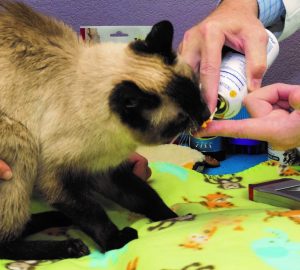 Rockey was another older animal in which this approach has made a difference. Described as “a cat who could make everyone at the practice want to call in sick,” Rockey was a skilled fighter who could tear you apart! Said Dr. Becker, “You could literally play ‘connect the dots’ with the injuries he could inflict on the team.” On Rockey’s cage, a sign read: “Caution: Fractious Cat!”
Rockey was another older animal in which this approach has made a difference. Described as “a cat who could make everyone at the practice want to call in sick,” Rockey was a skilled fighter who could tear you apart! Said Dr. Becker, “You could literally play ‘connect the dots’ with the injuries he could inflict on the team.” On Rockey’s cage, a sign read: “Caution: Fractious Cat!”
According to Dr. Becker, “I got his owner to give Rockey the magic carpet ride to the practice on a blanket sprayed with Feliway®, put a Thundershirt® on him, and use her vehicle in the parking lot as the waiting room. When Rockey came in, I wrote his name in EZ Cheese on a mat, and he started eating away. Before long he rubbed against me with his cheek and purred while the humans gasped in disbelief. We changed the sign on his carrier to: “Caution: Fearful Cat” which is more than words — it’s a thought process. The previous sign warned everyone to be prepared for battle. What we instead need to do for pets like Rockey is protect them. Realize their fear and cater to their comfort rather than fearing them.”
Dr. Becker concluded our conversation with words that ring so true, “Pets love us unconditionally. They make us smile and laugh. Most of us had no idea we were harming them emotionally. Owners and veterinarians care for our pets from ‘birth to earth,’ and along every step of the way, we must account for their emotional as well as their physical well-being.”
People in 34 countries have already become Fear FreeSM Certified, and plans are underway to begin issuing certifications to veterinary practices (like the American Animal Hospital Association – AAHA – does but looking for a different set of standards). The course materials are being translated into Spanish, Portuguese, Korean & Mandarin, and courses are in the works to care for birds, exotics and equines as well as specialty modules and content tailored to groomers and trainers. Certification is always free for veterinary students and those working in shelter medicine. Learn more at www.FearFreePets.com and www.FearFreeHappyHomes.com.
First Printed in THE PET PRESS, June/July/August 2018 Cover Story, and so very GRRateful that the article won a Maxwell Medallion Award from the Dog Writers Association of America in the Newspaper Articles or Column: General Health or Care category 2/10/10.
Please catch my VLOG on this topic: https://youtu.be/x8u31YpCucU __________________________________________________________
For 20 years Denise Fleck’s Sunny-dog Ink motto has been “Helping people to help their pets,” and she has…teaching more than 15,000 pet lovers animal life-saving skills and millions more on “The Doctors,” CNN, “Kirstie Alley’s Big Life,” Animal Planet and other TV shows. Denise is a frequent conference speaker, developed a line of pet first aid kits and now offers classes online.
Note: The articles on this page are copyrighted. Please do not reprint or use portions for any purpose without written permission from the author. Request permission for usage by sending an email explaining how you’d like to use the materials and what parts specifically. Thank you in advance!


